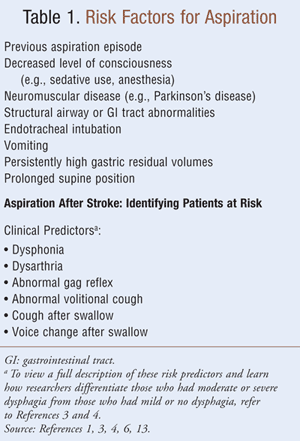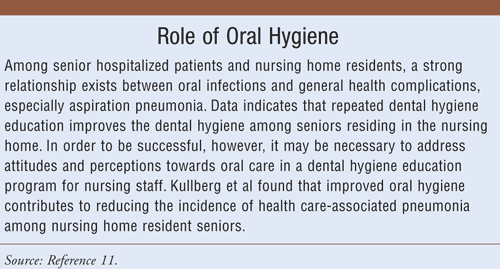In the elderly, the major risk factor for pneumonia is the presence of a serious comorbidity.1 Further, the likelihood of a serious outcome with pneumonia, including death, has been shown to be directly related to the number of comorbid illnesses.1 Seniors, people who are debilitated, those who have trouble swallowing (dysphagia), are intoxicated by alcohol or drugs, or are unconscious from anesthesia or a medical condition are especially at risk for aspiration pneumonia, a lung infection caused by inhaling mouth secretions, stomach contents, or both.2 Senior patients tend to aspirate due to a variety of conditions, such as 1) those that alter consciousness (e.g., sedative use, anesthesia) and 2) medical conditions causing difficulty in swallowing (e.g., dysphagia secondary to stroke).2 Approximately 55% of patients who have an acute stroke present with dysphagia.3,4 Forty percent to 70% of patients with dysphagia suffer silent aspiration, which can result in complications such as aspiration pneumonia.3,4
A stroke survivor may not be aware of food or liquid entering the airway, hence the term silent aspiration.5 Thin liquids are often hard to swallow safely after a stroke because they move quickly through the mouth and throat.5 Adequate time is necessary for the voice box (larynx) to make adjustment to protect the airway; if this does not occur properly, as in the patient with dysphagia secondary to stroke, aspiration may result.5 Normally, aspiration would cause a violent cough; however, this may not occur in a stroke survivor due to a reduction in sensation.5 Aspiration pneumonia is also considered the most serious complication associated with tube feeding (for an overview of dysphagia and tube feeding, refer to Reference 6).2,6
Daniels et al provides clinical predictors to identify patients at risk for aspiration after stroke (TABLE 1). These researchers indicate that clinical predictors of aspiration risk can be used to objectively differentiate patients with acute stroke who require further evaluation of swallow mechanics (see Swallowing Evaluation, below) from patients who do not.3,4

Pharmacists are in a position to provide recommendations to health care professionals regarding appropriate assessment and therapy for aspiration pneumonia, monitoring of pharmacotherapy, and guidance to stroke survivors and their caregivers regarding prevention of aspiration and which symptoms require the immediate attention of their health care provider.
Preventing Aspiration:
Swallowing Evaluation
Following a stroke, a speech-language pathologist is the trained professional who tests a patient's swallowing ability. The assessment includes 1) an evaluation of how well the muscles in the mouth move; 2) questions to determine if the patient can remember techniques they might need to learn; 3) listening to the patient's voice to evaluate voice box functioning; and 4) providing the patient with food and liquid to swallow, if necessary.5 Adequate nutrition is a concern in a patient with dysphagia; therefore, if it is not safe for an individual to swallow food, beverages, medications, etc. by mouth, the patient may require tube feeding.5
The speech-language pathologist obtains the necessary information from the swallowing evaluation to assist in developing an individualized treatment plan to help patients regain their swallowing skills.5 Generally, exercises to improve coordination of muscle movements in the mouth and throat are part of the treatment plan; a plan may also incorporate techniques to help compensate for lost function.5 Changes in food and liquids that a patient consumes may be made, such as thickened liquids and pureed foods to provide slower movement.5 Continual reassessment is necessary during a stroke survivor's progress to determine in an ongoing fashion when it is safe to eat more conventional foods.5
Patients and caregivers should be counseled regarding safeguards and precautions for swallowing such as positioning the body upright during eating or drinking, taking small bites and sips, ensuring all food is fully cleared from the mouth, and taking as much time as necessary to eat and drink.5 Pharmacists can provide information regarding which medications can and cannot be crushed, and other tips on appropriate medication administration in this population.
Pathophysiology
When prevention of aspiration is ineffective, minute particles from the mouth are typically inhaled (i.e., aspirated) or flow in drops into the airways.2 In these instances, clearance is achieved by normal defense mechanisms (e.g., coughing) prior to particles reaching the lungs, where they can induce inflammation or infection.2 If particles are not cleared appropriately, due to faulty defense mechanisms or too large a volume of particles, aspiration pneumonia ensues.2
Patients with post-stroke dysphagia who have aspiration pneumonia usually present as a case of community-acquired pneumonia with a focal infiltrate in a dependent bronchopulmonary segment.7,8 These patients require treatment with broad-spectrum antibiotics and management of the underlying dysphagia.7
Aspiration pneumonitis (chemical pneumonitis) occurs from the aspiration of gastric contents, usually in patients with a markedly decreased level of consciousness. Chemical pneumonitis occurs upon aspiration of material known to be toxic to the lungs.2 Many substances are directly toxic to the lung or induce an inflammatory response when aspirated; gastric acid is the most common aspirated substance; others include inhalation of laxative oils (e.g., mineral, castor, and paraffin oils) and hydrocarbons (e.g., gasoline, kerosene, and petroleum products).2,9 The insult of chemical pneumonitis is mostly a result of irritation rather than infection.2 Aspiration pneumonia and pneumonitis are common clinical syndromes in hospitalized patients.7
Of note, as many as 30% to 50% of patients with serious chemical pneumonitis due to inhaled stomach acid die.2
Signs and Symptoms of
Aspiration Pneumonia
Symptoms of aspiration pneumonia may not begin for at least 1 to 2 days.2 Symptoms include cough producing a putrid, foul-tasting sputum (may be streaked with blood, or appear as a frothy fluid), shortness of breath (i.e., chronic low-grade dyspnea), fever, and weight loss.2,10 Patients may also present with chills; diaphoresis; tachypnea; tachycardia; chest pain when coughing or upon inspiration; fainting, dizziness, confusion; anxiety; and dusky or blue color to skin, lips, or fingernails.10 Additionally, patients may have signs of poor oral hygiene (see Role of Oral Hygiene sidebar.11).2 Signs and symptoms may depend on the type and quantity of material inhaled; signs and symptoms of aspiration pneumonia can worsen very quickly.10

Febrile response in the elderly may be blunted or absent; only 33% to 60% of seniors present with a high fever.1,12 Cough and sputum production in the elderly are often subtle and incompletely expressed.1 Because of this, diagnosis may be obscured and result in delayed therapy, which may have a negative effect on outcome.12 Elderly patients with pneumonia typically present with acute confusion or delirium and a deteriorating baseline functional status; presenting signs may be tachypnea and tachycardia.1
Diagnosis is made on the basis of signs and symptoms and a chest x-ray.2 Chest x-ray shows an infiltrate, often in the dependent lung segments (i.e., the superior or posterior basal segments of a lower lobe or the posterior segment of an upper lobe).2
Treatment
Treatment and prognosis differ depending on the substance that was aspirated.2 Aspiration pneumonia requires antibiotic therapy, which may include clindamycin, amoxicillin plus clavulanate, ampicillin, and imipenem; renal function should be monitored for toxicity.2,12 Management of the underlying dysphagia is also recommended (refer to Reference 5).7 If a solid particle has been inhaled, bronchoscopy may be necessary for removal.2 Treatment of aspiration pneumonitis is primarily supportive, although corticosteroids and other agents that modulate the immune system response may have a role in these patients.7
Conclusion
The most frequent infectious cause of death in elderly patients is pneumonia.12 Since the presence of a serious comorbidity is the major risk factor for pneumonia in the elderly, stroke patients should be evaluated for aspiration risk. Pharmacists can assist stroke survivors and their caregivers through guidance on ways to reduce the risk of aspiration regarding ingestion of food, beverages, and medication.
REFERENCES
1. Beers MH, Jones TV, Berkwits M, et al, eds. The Merck Manual of Geriatrics. 3rd ed. Whitehouse Station, NJ: Merck Research Laboratories; 2000:758-762.
2. Aspiration pneumonia. The Merck Manual of Medical Information Second Home Edition. Revised April 2008.
www.merck.com/mmhe/print/
3. Daniels SK, Ballo LA, Mahoney MC, et al. Clinical predictors of dysphagia and aspiration risk: outcome measures in acute stroke patients. Arch Phys Med Rehabil. 2000;81:1030-1033.
4. Miller KE. Using clinical predictors for aspiration risk after stroke. Tips from other journals. Am Fam Physician. 2001;63:552.
www.aafp.org/afp/2001/0201/
5. Difficulty Swallowing After Stroke. American Stroke Association, a division of American Heart Association.
www.strokeassociation.org/
6. Kumpf VJ, ChessmanKH. Enteral Nutrition. In DiPiro JT, Talbert RL, Yee GC, et al, eds. Pharmacotherapy: A Pathophysiologic Approach. 7th ed. New York, NY: McGraw-Hill Inc; 2005:2399-2416.
7. Marik PE. Aspiration syndromes: aspiration pneumonia and pneumonitis. Hosp Pract (Minneap).
8. Beers MH, Jones TV, Berkwits M, et al, eds. The Merck Manual of Health & Aging. Whitehouse Station, NJ: Merck Research Laboratories; 2004: 206,332,717-720,739.
9. Aspiration Pneumonitis and Pneumonia. Merck Manual Online. Revised May 2008.
www.merck.com/mmpe/sec05/
10. Aspiration pneumonia. Drugs.com.
www.drugs.com/cg/aspiration-
11. Kullberg E, Sjögren P, Forsell M, et al. Dental hygiene education for nursing staff in a nursing home for older people. J Adv Nurs. 2010;66:
1273-1279.
12. Kane RL, Ouslander JG, Abrass IB. Essentials of Clinical Geriatrics. 5th ed. New York, NY: McGraw-Hill, Inc; 2004:324-328.
13. McClave SA, DeMeo MT, DeLegge MH, et al. North American summit on aspiration in the critically ill patient: Consensus statement. J Parenter Enteral Nutr. 2002;26(6 suppl):S80-S85.
To comment on this article, contact rdavidson@uspharmacist.com.






